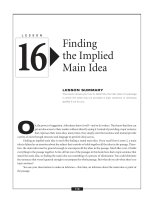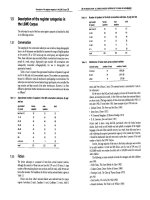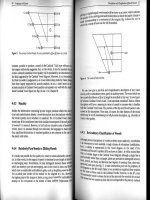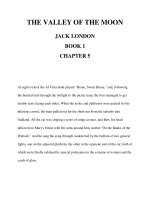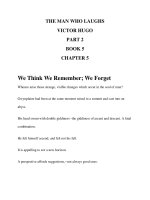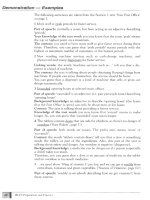Finding main idea 5 pot
Bạn đang xem bản rút gọn của tài liệu. Xem và tải ngay bản đầy đủ của tài liệu tại đây (83.51 KB, 6 trang )
Practice Passage 3
Read the following paragraph, which describes a local community event.
– START FROM THE BEGINNING: CHRONOLOGICAL ORDER–
56
The International Dinner raised $15,000 to renovate the Berkshire Park Com-
munity Center. Three-hundred and fifty people attended the dinner, which was
held in the ballroom of a local hotel. Tickets were sold in advance for $50 each.
The attendees left the event feeling very good about their community. The Berk-
shire Park Community Center was damaged in a fire six months ago. An ener-
getic committee of eight community members came up with the idea of the
International Dinner to raise funds to repair the damages. The plan was to cel-
ebrate the diversity of the Berkshire Park Neighborhood Association by serving
ethnic food that represents the various cultures in the neighborhood. The com-
mittee also organized a silent auction with prizes donated by local businesses to
take place during the dinner. The committee chairperson talked to a local news-
paper reporter at the dinner and stated that the goal was to raise $10,000. A
follow-up letter to community members thanked everyone for the huge success
of the fundraiser and outlined a schedule for the renovation.
Notice that this paragraph is not arranged in
chronological order. Take the ten different events that
make up the story and rearrange them so that they are
in chronological order.
Here’s the order of events as they are presented in
the story.
■
The International Dinner raised $15,000 to reno-
vate the Berkshire Park Community Center.
■
Three-hundred and fifty people attended the
dinner.
■
Tickets were sold for $50 each.
■
The attendees left the event feeling very good
about their community.
■
The Community Center was damaged in a fire six
months ago.
■
A committee of eight community members came
up with the idea of the International Dinner to
raise funds for repairs.
■
The plan was to serve foods that represent the var-
ious cultures in the neighborhood.
■
The committee organized a silent auction to take
place during the dinner.
■
The chairperson talked to a local newspaper
reporter stating the goal was to raise $10,000.
■
A letter to community members thanked everyone
and outlined the schedule for renovation.
Now put the events in chronological order.
1.
2.
3.
4.
5.
6.
7.
8.
9.
10.
Now, take these chronologically ordered events
and make them into a cohesive paragraph. To do this,
you need to add transitional words and phrases. Here
is a list of transitional words and phrases often used in
chronologically organized passages:
Write your paragraph, putting the events in
chronological order with transitional phrases, below or
on a separate piece of paper.
Answers
There are, of course, many possible ways of using tran-
sitional words and phrases to put this story in chrono-
logical order. One paragraph might look like this:
The Berkshire Park Community Center was dam-
aged in a fire six months ago. S
oon after, a commit-
tee of eight community members came up with the
idea of an International Dinner to raise funds to
repair the damages. The plan was to serve foods that
represent the various cultures in the neighborhood.
I
n addition, the committee organized a silent auc-
tion to take place during the dinner. B
efore the event,
tickets were sold for $50 each. D
uring the dinner, the
committee chairperson talked to a local newspaper
reported and stated that the goal was to raise
$10,000. Three-hundred and fifty people attended
the event which raised $15,000. W
hen the attendees
left the event, they felt very good about their com-
munity. A
fter the event, a letter was sent to com-
munity members thanking them for everything
w
hile outlining a schedule for renovation.
first
second
third
next
now
then
when
as soon as
immediately
suddenly
soon
after
before
during
while
meanwhile
in the meantime
at last
eventually
finally
– START FROM THE BEGINNING: CHRONOLOGICAL ORDER–
57
Practice Passage 4
Chronological order is very important, especially when
it comes to procedures. If you perform the steps out of
chronological order, you won’t get the results you
desire. Just imagine, for example, that you are trying to
bake a cake. What happens when you do things out of
order? You go without dessert.
Of course, the consequences of not following
proper chronological order at work can be much more
serious, so it’s important that you strengthen this skill.
Read the following paragraph, marking it up to help
you keep track of the steps that an employee must fol-
low to get tuition reimbursement.
– START FROM THE BEGINNING: CHRONOLOGICAL ORDER–
58
Our company will be happy to reimburse you for college courses that enhance
your job performance. Before you register for the course, you must get approval
first from your immediate supervisor and then from Human Resources. If you
are taking the course for credit, you must receive a C+ or better in the course. If
you are not taking it for credit, you must pass the course. After you have com-
pleted the course, you must write a report explaining the content of the course
and its relevance to your position. Then, you must fill out a reimbursement
request. Attach a tuition payment receipt, your report, and a copy of your grades
to this request and promptly submit this request to your supervisor. Once your
supervisor has approved the request, you can then submit all these forms to
Human Resources, and you should receive your check within two weeks.
There are eight separate steps an employee must
take to be reimbursed for college course work. What are
they? List them below in the order in which the
employee must do them.
1.
2.
3.
4.
5.
6.
7.
8.
If you marked up your paragraph, you should easily see the different steps. Here’s how you might have marked
it up. The transitional words and phrases are highlighted in bold.
– START FROM THE BEGINNING: CHRONOLOGICAL ORDER–
59
Our company will be happy to reimburse you for college courses that enhance
your job performance. Before you register for the course, y
ou must get appr
oval
first fro
m your immediate superv
isor and then fr
o
m Human Resources.Ifyou
are taking the course for credit, you must receive a C+
or better in the course. If
you are not taking it for credit, you must pass the course. After you have com-
pleted the course, you must w
rite a report
explaining the content of the course
and its relevance to your position. Then, you must fil
l out a reimbur
se-
ment r
equest. Attach a tuition pa
yment re
ceip
t,your repor
t, and a copy of
your
g
rades to this request and promptly submit this request to your supervisor. Once
your supervisor has approved the request, you can then s
ubmit all these fo
rms to
H
uman Resourc
es, and you should receive your check within two weeks.
If you miss a step in this process, you won’t be
reimbursed. Thus, it’s critical that you be able to iden-
tify each step and the order in which the steps must be
taken.
Summary
Chronological structure is, of course, a very useful
organizational pattern. Events happen in a certain
order, so writers often present them in that order. Keep
an eye out for the transitional words and phrases that
signal this type of organization.
need approval
before registering!
1
st
–get supervisor
approval
2
nd
–get HR approval
3
rd
–take course–
get C+
or better!
4
th
–write report
5
th
–fill out reimb.
request
6
th
–attach tuition,
report + grades
to request
7
th
–submit to
supervisor
8
th
–submit to HR
1
2
3
4
5
6
7
8
■
As you think about things today, try to organize them chronologically. If you think back to something
that happened over the weekend, for example, think about it in the order it happened: First ____, then
_______, suddenly, ______, and so on.
■
As you read about events in the newspaper or in other places, put the different pieces of each event
in chronological order, as you did with the story about the International Dinner.
Skill Building until Next Time
t’s a scientifically proven fact: People remember most what they learn first and last in a given session. Writ-
ers have instinctively known this for a long time. That’s why many pieces of writing are organized not in
chronological order but by order of importance.
Imagine again that the writer is like an architect. How would this type of writer arrange the rooms? By hier-
archy. A hierarchy is a group of things arranged by rank or order of importance. In this type of organizational pat-
tern, hierarchy, not chronology, determines order. Thus, this architect would lay the rooms out like so: When you
walk in the front door, the first room you encounter would be the president’s office, then the vice president’s, then
the assistant vice president’s, and so on down to the lowest ranking worker. Or, vice versa, the architect may choose
for you to meet the least important employee first, the one with the least power in the company. Then the next,
and the next, until at last, you reach the president.
Likewise, in writing, ideas may be arranged in order of importance. In this pattern, which idea comes first?
Not the one that happened first, but the one that is most,or least, important.
LESSON
Order of
Importance
LESSON SUMMARY
Continuing your study of the structure of reading material, this lesson
shows you how writers use order of importance—from least to most
important or from most to least important. Understanding this commonly
used structure improves your reading comprehension by helping you
see what’s most important in a piece of writing.
7
61
